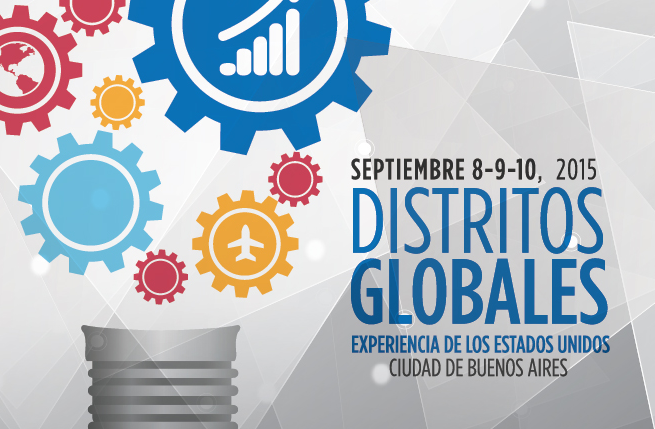Innovation Districts, Prosperity Zones, Creative Districts or Tech Towns—no matter what the terminology, the concept of concentrating industries, technologists, companies, entrepreneurs, and R&D within a definable geography is top of mind for many in the economic development community. Prime locations are usually dense urban environments offering mixed-use real estate, allowing residents to work, learn, and have fun all in the same neighborhood. Examples and elements of these districts are being studied by economists, think tanks, and economic developers alike. Best practice models are scattered around the US, often led by public-private collaborations. Examples include Seattle’s South Lake Union, Detroit’s Downtown and Midtown developments, and recent developments in downtown Las Vegas. Sometimes these districts are executed by formal, organized efforts with specific boundaries, and sometimes they grow from an organic process with informal boundaries. However they take root, successful districts have generated a lot of attention and inspired many communities to pursue similar approaches in hopes of stimulating job creation.
The Summit
In September, I was honored to join some of the most knowledgeable and successful thought leaders in economic development from across the US to participate in the City of Buenos Aires’s Global Districts Summit in Argentina. The Summit was driven by the city’s motivation to share best practices in the creation and sustainability of economic development districts with a focus on public policy, entrepreneurship, and international business development. My fellow US delegates included leaders from the Research Triangle Park, Ann Arbor SPARK, Creative Oklahoma, the University South Carolina, IAE Business School, and the Center for Strategic International Studies out of DC.
The conference began with a full day tour of the city’s five creative districts dedicated to technology, audiovisual, arts, design, and sports/entertainment. The districts were established in 2008 to address blight, unemployment, and poverty in economically disadvantaged areas. The goal of the districts program is to attract new investment, jobs, and redevelopment. A daylong workshop followed, discussing the districts’ accomplishments and ways in which the city could improve and expand on what has been completed. The summit culminated in a half-day public forum attended by over 200 dignitaries, business leaders, and city officials. This forum is where I and other delegation representatives shared our thoughts on lessons learned from other districts around the world and suggested opportunities the Buenos Aires districts could pursue in the future. An enthusiastic keynote address, about the possibilities that innovation holds for Argentina, was given by Guibert Englebienne. Guibert, who is regarded as the Steve Jobs or Bill Gates of Argentina, is co-founder of Globant, the country’s largest technology company with more than 4,300 employees serving clients like LinkedIn, Zynga, and Google.
The Takeaway
At TIP Strategies, we think about successful economic development efforts in terms of Talent, Innovation, and Place. These three components are critical to a successful economic development district as well as to the region in which that district is located. What follows is an outline of some of what is happening in the City of Buenos Aires and its creative districts, as well as ideas that were shared by the delegation, as they relate to Talent, Innovation, and Place:
Talent: Buenos Aires exudes excitement and energy. Its architectural beauty, vibrant art, culture, and nightlife act as a magnet for the creative class. The city also has over 30 universities and colleges within its boundaries. Buenos Aires has made meaningful commitments to strengthen its talent base. One effort is a partnership with three universities, including the prestigious Technology Institute Buenos Aires, to collectively build a new campus in the heart of the technology district. The production of more trained engineers is imperative; roughly 40% of engineering graduates from local schools leave the country to work elsewhere. This is an unacceptable loss of a precious asset. The delegation agreed that all efforts must be made to keep and grow this engineering talent if the districts, city, and country are to be successful.
Innovation:The rapid success of Globant is proof that innovation and entrepreneurship is alive and well in the Buenos Aires region. The city has received international recognition for its growing software industry, drawing attention from companies and technology leaders in places like Silicon Valley. But recognition and international contracts for only the largest firms is not enough. Technology businesses within the district primarily serve back-office functions for business and government clients within Argentina. If businesses within the district are going to succeed, their customer base must be larger than the opportunities within the country’s borders. The city can help attract international business for its emerging tech cluster. Additionally, the city’s university system has focused its energy on the production of skilled students, which is vital, but not enough to achieve success. The conference’s US delegation encouraged an emphasis on research and development and technology commercialization out of these institutions as well.
The city also has a fledgling entrepreneurship program. The program has limited staff and resources with a broad directive to help the people of Buenos Aires create their own business. The US conference attendees recommended that the program narrow its focus to just serving entrepreneurs in the sectors that align with the districts, rather than a more general approach.
Place: Buenos Aires benefits from attributes that create fertile ground for innovation districts: a dense population and mix of residential and commercial activity, served by mass transit. In this respect, the city is fortunate; it didn’t have to create this environment, like many other cities with similar ambitions have to do. In 2008, the city took bold steps to establish the creative districts, identifying areas of focus, setting boundaries, establishing tax incentives to encourage investment and relocation, and making the catalyst investment of building a new state-of-the-art city hall in the technology district. The new city hall not only serves as an architectural gem, it is a statement that the city is committed to the districts’ success. Many businesses have responded—with over 200 firms locating in the technology district alone. They are all benefiting from incentives and infrastructure investments made by the public sector. The US delegation unanimously agreed: if the districts are to meet their potential, the business community must now take a larger leadership role. We encouraged a new formal partnership between the city and the business community with dedicated staff and programming to address the districts’ opportunities and ongoing needs. This kind of initiative would require that the city give up some control; this is necessary to achieve the city’s goals for the districts and ensure their sustained, long-term success.
The concept of innovation/creative districts translates around the world. Concentrating industries, entrepreneurs, and technologists creates an abundance of opportunities that may produce new businesses, investments, and jobs. The Buenos Aires creative district program was established just seven years ago, and they have already generated palpable success. These districts serve as an inspiration to communities everywhere. If it keeps on this path, the city will reach its ambition of being the unquestionable technology capital of South America and will provide jobs and opportunity to its people. Buenos Aires is a place economic development practitioners need to watch.
To learn more about the City of Buenos Aires creative districts visit:
https://turismo.buenosaires.gob.ar/en
I welcome the opportunity to discuss innovation districts with you and learn about the economic development efforts in your community. Please feel free to contact me at jeff@tipstrategies.com.



